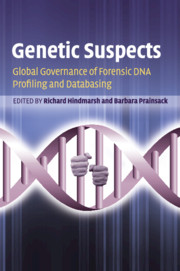Book contents
- Frontmatter
- Contents
- List of contributors
- About the contributors
- Foreword
- Acknowledgements
- 1 Introducing Genetic Suspects
- Section 1 Key areas in DNA profiling and databasing
- 2 Key issues in DNA profiling and databasing: implications for governance
- 3 Forensic utilization of voluntarily collected DNA samples: law enforcement versus human rights
- 4 Base assumptions? Racial aspects of US DNA forensics
- 5 Health and wealth, law and order: banking DNA against disease and crime
- 6 DNA profiling versus fingerprint evidence: more of the same?
- Section 2 National contexts of forensic DNA technologies and key issues
- Section 3 Conclusions
- Index
- References
5 - Health and wealth, law and order: banking DNA against disease and crime
from Section 1 - Key areas in DNA profiling and databasing
Published online by Cambridge University Press: 05 October 2012
- Frontmatter
- Contents
- List of contributors
- About the contributors
- Foreword
- Acknowledgements
- 1 Introducing Genetic Suspects
- Section 1 Key areas in DNA profiling and databasing
- 2 Key issues in DNA profiling and databasing: implications for governance
- 3 Forensic utilization of voluntarily collected DNA samples: law enforcement versus human rights
- 4 Base assumptions? Racial aspects of US DNA forensics
- 5 Health and wealth, law and order: banking DNA against disease and crime
- 6 DNA profiling versus fingerprint evidence: more of the same?
- Section 2 National contexts of forensic DNA technologies and key issues
- Section 3 Conclusions
- Index
- References
Summary
INTRODUCTION
In the 1990s, genetic databases moved into the mainstream, no longer limited to disease registers of affected families and other collections for specific research projects. The creation of large population-based collections of DNA samples linked to other information was supported by significant economic and political investment. This investment was driven by the promise that these new techno-scientific initiatives would deliver a variety of benefits for society, including economic competitiveness, improved public health, more effective law enforcement and greater security. In the field of criminal justice, forensic science organisations and police forces established DNA databases containing samples from offenders or suspects. In the medical realm, research institutions and governments created databases, more usually called biobanks, for the purposes of undertaking biomedical research. Until recently, forensic databases have not attracted particular attention from the media, public or social researchers, whereas biomedical databases have been seen by ethicists, politicians, policy advisors, lawyers and social scientists to give rise to many issues of public concern such that their formation has been the subject of intense scrutiny.
Some commentators have drawn comparison between the two scientific, technological and social arenas of law enforcement and biomedicine to highlight differences and incongruences between forensic and medical research databases and their governance. They point out, for example, that owing to a focus on concerns such as consent and privacy by those writing about biomedical databases, forensic databases have not received as much attention (Williams 2005; Levitt 2007).
- Type
- Chapter
- Information
- Genetic SuspectsGlobal Governance of Forensic DNA Profiling and Databasing, pp. 85 - 104Publisher: Cambridge University PressPrint publication year: 2010
References
- 6
- Cited by



